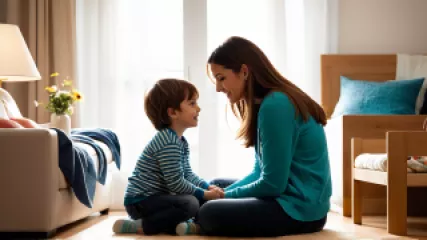Navigating the Parent-Child Relationship: A Personal Journey
Navigating the Parent-Child Relationship: A Personal Journey
The Journey Begins
As a parent, the relationship with my child has been one of the most profound and transformative experiences of my life. It is a bond that has challenged me, inspired me, and forced me to grow in ways I never could have imagined. Like many parents, I entered this journey with a mix of excitement, trepidation, and a deep desire to get it right.
From the moment my child was born, I was overwhelmed by the sheer intensity of the love I felt. It was as if my heart had expanded to accommodate this new little being, and I was consumed by an all-encompassing need to protect, nurture, and guide them. Yet, as I quickly learned, the parent-child relationship is far more complex than I had ever anticipated.
The Challenges of Parenthood
In the early days, the challenges of parenthood were almost overwhelming. The lack of sleep, the constant demands, and the steep learning curve left me feeling exhausted and questioning my ability to be the parent my child deserved. I found myself navigating a delicate balance between meeting my child's needs and maintaining my own sense of self.
One of the most significant challenges I faced was learning to effectively communicate with my child. As an infant, their needs were primarily expressed through cries and gestures, and I had to become attuned to the subtle nuances of their communication. As they grew older, the complexities of our exchanges evolved, and I found myself constantly adapting my approach to ensure I was truly understanding and responding to their needs.
Discipline was another area that required a great deal of trial and error. I wanted to strike the right balance between setting boundaries and fostering my child's independence and self-discovery. It was a delicate dance, and I often found myself second-guessing my decisions, wondering if I was being too strict or too lenient.
Embracing the Emotional Journey
Alongside the practical challenges of parenting, I also had to navigate the emotional roller coaster that comes with the parent-child relationship. The joys and triumphs were profound, but so were the moments of frustration, guilt, and self-doubt.
I vividly remember the first time my child accomplished a new milestone, the pure elation and pride that surged through me. It was as if their success was my own, and I found myself marveling at the incredible resilience and determination they displayed. These moments of celebration were truly cherished, reminders that the hard work and sacrifices were all worth it.
However, the emotional journey was not without its challenges. There were times when I felt overwhelmed by the weight of my responsibilities, questioning whether I was providing my child with the love, guidance, and support they needed. The guilt and self-doubt that crept in during these moments were almost crippling, and I had to learn to be kinder to myself, to acknowledge that perfection was an unrealistic goal.
Developing Emotional Intelligence
As I navigated the complexities of the parent-child relationship, I realized that one of the most critical skills I needed to cultivate was emotional intelligence. Being attuned to my child's emotional needs, as well as my own, was essential in fostering a healthy and nurturing bond.
I began to actively work on developing my own emotional intelligence, learning to recognize and manage my emotions in a constructive manner. This involved practices such as mindfulness, self-reflection, and seeking support from trusted friends and family members. By understanding and addressing my own emotional needs, I was better equipped to respond to my child's emotional well-being with empathy and understanding.
Cultivating emotional intelligence also allowed me to navigate the complex dynamics of discipline and boundary-setting more effectively. Instead of relying solely on punitive measures, I learned to approach these situations with a focus on problem-solving, communication, and building a sense of trust and cooperation with my child.
Fostering Bonding Activities
In addition to developing emotional intelligence, I found that engaging in intentional bonding activities with my child was crucial for strengthening our relationship. These activities ranged from simple daily routines, like reading bedtime stories or taking walks together, to more structured experiences, such as family outings or creative projects.
Through these shared moments, I witnessed the profound impact that quality time and undivided attention could have on my child's emotional development and sense of security. I observed how their confidence blossomed, their communication skills improved, and their ability to express their emotions grew stronger.
Moreover, these bonding activities provided me with a deeper understanding of my child's unique personality, interests, and needs. It was during these moments of connection that I truly came to appreciate the individual they were becoming, and it fueled my desire to continue nurturing and supporting their growth.
Navigating the Evolving Relationship
As my child grew older, the nature of our relationship continued to evolve, presenting new challenges and opportunities for growth. The toddler years brought a newfound sense of independence and a desire for autonomy, which required me to adjust my parenting approach to strike a balance between guidance and respect for their emerging self-identity.
The elementary school years introduced a whole new realm of social and academic demands, and I found myself needing to navigate the delicate balance between being a supportive, involved parent and allowing my child the space to develop their own problem-solving skills and coping mechanisms.
And as my child entered adolescence, the relationship shifted once more, with a greater emphasis on open communication, mutual understanding, and a shared journey of self-discovery. During this pivotal stage, I worked to maintain a strong emotional connection while also respecting their burgeoning need for independence and the exploration of their own identity.
Embracing the Uncharted Path
Throughout this journey, I have come to realize that the parent-child relationship is not a static one, but a constantly evolving dynamic that requires ongoing attention, adaptation, and a willingness to embrace the unknown. Each stage of my child's development has presented its own unique challenges and opportunities, and I have had to continuously reevaluate my approach, drawing upon the lessons I've learned and the emotional resources I've cultivated along the way.
Perhaps the most valuable lesson I've learned is the importance of embracing the uncharted path. As a parent, I have had to let go of the idea of perfection and the belief that there is a single, definitive "right" way to navigate this relationship. Instead, I have learned to approach each situation with an open mind, a willingness to learn, and a deep respect for the individuality of my child.
This has meant being comfortable with uncertainty, adapting to changing circumstances, and allowing room for mistakes and growth, both for myself and my child. It has required me to cultivate patience, empathy, and a deep well of resilience – qualities that have not only strengthened my relationship with my child but have also enriched my own personal development.
Reflections and Gratitude
As I look back on this journey, I am filled with a profound sense of gratitude. The parent-child relationship has been a transformative experience, one that has challenged me, humbled me, and ultimately helped me to become a better version of myself.
I am grateful for the moments of joy and laughter, the shared discoveries, and the deep bonds of trust and understanding that have grown between us. I am thankful for the opportunities to learn, to grow, and to witness the incredible resilience and potential of my child.
And while the path ahead may still hold uncertainties and challenges, I am confident in my ability to navigate them with the lessons I've learned and the unwavering love I feel for my child. This relationship has become a cornerstone of my life, shaping my priorities, my values, and my understanding of what it means to truly be a part of something greater than myself.
As I continue on this journey, I am filled with a sense of wonder and anticipation, eager to see what the future holds and how our relationship will continue to evolve. I know that there will be more ups and downs, more moments of triumph and struggle, but I am committed to approaching each one with an open heart and a deep appreciation for the incredible gift of parenthood.
In the end, the parent-child relationship is a profoundly personal and dynamic experience, one that defies simple explanations or universal solutions. It is a journey of self-discovery, of emotional growth, and of the most powerful bonds we can ever hope to forge. And as I continue to navigate this uncharted path, I am grateful for the opportunity to learn, to love, and to be forever changed by the child who has become the center of my world.






